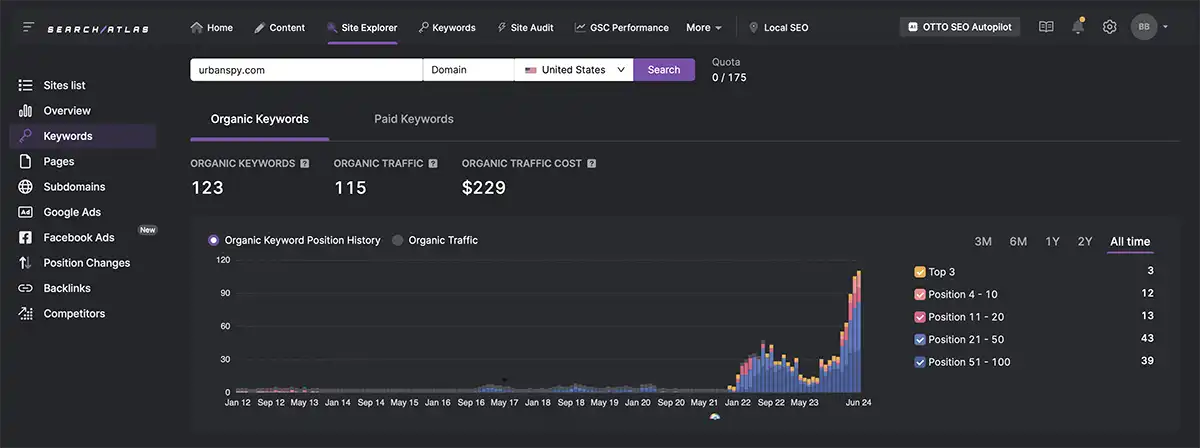
Climbing the ranks on Google’s search results isn’t just a matter of chance, it’s a strategic conquest requiring insight, precision, and a touch of creativity.
In your quest to secure the top spot and gain the enviable visibility that drives traffic to your site, understanding the intricacies of Search Engine Optimization (SEO) is paramount.
From unraveling the fundamentals of SEO to mastering local search dynamics and leveraging cutting-edge tools, the path to outmaneuvering your competition is both varied and demanding.
Keep reading to unlock the secrets of soaring past your rivals on the digital leaderboard.
Understanding SEO: Basics and Importance
Embarking on the journey to outrank your competition on Google starts with a solid grasp of SEO. Imagine SEO as the compass that guides Google through the vast digital landscape to find your content. It’s not just about throwing in a few keywords and hoping for the best; it’s about understanding how search engines think, what they value, and how they rank content.
Your first aim should be to make your website irresistible to search engines. Think of your website’s structure, speed, mobile-friendliness, and user experience as critical components that search engines scrutinize when ranking sites. Your content must not only captivate and engage but also meet the technical expectations of these digital entities.
Your digital presence must resonate with authority, relevance, and trustworthiness. Imagine every backlink to your site as a vote of confidence in the eyes of Google, aligning with the notion that the more reputable the source, the more valuable the endorsement. Crafting content that others want to reference positions you as a thought leader, giving you an edge over your competitors.
Elevate Your Strategy with High-Quality Backlinks
- Benchmark Against Competitors: Start by assessing the number of backlinks your competitors have. This will give you a target to aim for, helping you understand the scale of effort needed to compete effectively.
- Prioritize Quality over Quantity: Google values backlinks from high Domain Authority (DA) sites. Focus on acquiring links from reputable sources rather than merely increasing the number of backlinks.
- Create Compelling Outreach Materials: Develop infographics, blog posts, and videos that not only engage your audience but also attract attention from other sites. These materials can serve as powerful tools in your backlink strategy.
- Seek Relevant Opportunities: Keep an eye out for related websites where you can naturally create links. Leverage SEO and SEM tools or CRMs to identify these opportunities and streamline your efforts.
By implementing these strategies, you can not only enhance your backlink profile but also solidify your position as a credible voice in your industry.
Consistency and quality in your content creation are your allies in the quest to top rankings. By routinely updating your site with fresh, original, and valuable material, you signal to Google that your site remains relevant and worth visiting. Stagnation is your enemy; growth and adaptability are your friends, propelling you towards that coveted top spot in search results.
How can you determine the search intent of users to create better content?
Understanding user search intent is crucial for crafting content that truly resonates with your audience. Here’s how you can get started:
Analyze Top-performing Content
- Research High-ranking Pages: Examine the pages that rank well across search engines like Google. Identify common themes, keywords, and formats. Tools such as SEMrush and Ahrefs can provide insights into top-performing content for specific keywords.
- Social Media Trends: Monitor popular topics and discussions on platforms like Twitter, LinkedIn, or Reddit. These channels can reveal what your target audience values and discusses.
Address User Needs
- Search Queries: Pay attention to the specific phrases people use. Tools like Google Keyword Planner or Ubersuggest can help identify common queries and their variations.
- Content Analysis: Focus on content that helps users fulfill their goals. Determine if they’re looking for educational information, transaction details, or specific solutions.
Implement a Strategic Approach
- Categorize Search Intent: Break it down into informational, navigational, transactional, and commercial investigation. This helps tailor content to the different stages of the buyer’s journey.
- Feedback and Engagement: Use comments, shares, and user feedback on your existing content as clues to what resonates and what might need adjustment.
By deeply understanding what users are seeking, you can create content that not only meets their expectations but also encourages engagement, leading to higher conversions.
Diving Into Local SEO: Strategies for Visibility

Transforming your online visibility within your community hinges upon executing a robust local SEO strategy.
You must fine-tune your digital presence to ensure when locals search, your business surfaces as the go-to solution in your niche.
This means enhancing your Google Business Profile, ensuring your business is accurately listed across the digital sphere, and optimizing your website specifically for local SEO — each step is a critical puzzle piece in the larger picture of local dominance.
By mastering these facets, you stand to not only increase your visibility but also position your brand as the local authority, capable of outmaneuvering competitors in your area.
Local SEO: Leveraging Google Business Profile
Securing a premier spot in local search results necessitates an optimized Google Business Profile. Your diligence here ensures that pertinent details—operating hours, location, and services—are meticulously aligned with the queries of your local audience, amplifying your visibility right at the moment potential customers are in pursuit of offerings like yours.
Engage with your community through your Google Business Profile by regularly posting updates, responding to reviews, and adding vivid images that reflect the character of your business. This active participation not only enhances your profile’s appeal but signals to Google the vibrancy and relevance of your business, aiding in ascending the ranks against local competitors.
Local SEO: Local Listings
Securing elevated visibility through local listings is pivotal for any business aiming to dominate local search. Strategize by placing your business information on prominent platforms such as Yelp, TripAdvisor, or industry-specific directories to boost local discoverability.
Accuracy is paramount: Ensure your business details are consistent across all listings. A typo in your address or mismatched contact info can erode your credibility and impede your quest to outshine competitors in local searches:
- Review and standardize your business’s name, address, and phone number on every platform.
- Identify and correct inaccuracies or outdated information to maintain consistency.
- Mobilize customer reviews on these listings to reinforce trust and authority.
Local SEO: Enhancing Your Website for Local SEO
To catapult your website to the zenith of local search results, instill a sense of place within your online content. Incorporate region-specific keywords and phrases that echo the vernacular of your community, enabling your site to reverberate more profoundly with local users and search engine algorithms alike.
Remember that on-page optimization extends beyond textual content; it includes local signals in meta tags and descriptions, too. Tailor these elements to sing of your locality, ensuring that each page on your site not only provides value but also exhibits a clear tether to your community, enhancing its relevance in the eyes of both your audience and Google’s discerning algorithms.
Technical SEO: A Comprehensive Guide

To secure a top position in Google’s rankings, you need to pay close attention to the gears and cogs that work behind the scenes of your website and your custom website design.
Technical SEO is that silent force, working tirelessly to ensure that your online presence isn’t just visible, but also attractive to search engine algorithms.
Addressing elements such as keywords, meta tags, page URLs, heading tags, page content, image optimization, and page loading speed will empower your digital footprint to stand steadfast against the tide of competition.
Let’s delve into these components, equipping you with the toolkit needed to refine your website into a well-oiled machine that outperforms your industry rivals.
Technical SEO: Keywords
To outpace your rivals in search engine rankings, intricately weaving keywords into the tapestry of your website’s content is essential. Select terms that mirror the queries your audience might use when seeking out your products or services on Google.
Aligning your content with well-researched keywords bolsters your relevance and enhances your discoverability. Be strategic: use a blend of broad and long-tail keywords tailored to your niche:
- Utilize broad terms to attract a wider audience.
- Incorporate specific, long-tail keywords for targeted user intent.
- Analyze and adjust your keyword strategy in response to search trends and competitive insights.
To uncover the keywords your competitors are leveraging, follow these steps:
- Create a Competitor List: Begin by compiling a spreadsheet that includes your top competitors along with their key webpages, such as the homepage and main product pages.
- Visit Each Webpage: Manually navigate to each competitor’s site. Once there, access the source code for these pages. This can typically be done by right-clicking anywhere on the page and selecting “View Page Source” or “Inspect”.
- Examine Page Elements: In the source code, pay special attention to the page title, meta descriptions, and headings (H1, H2, etc.). These elements often contain the primary keywords that the site is targeting.
- Analyze Content: Look closely at the body content as well. Frequent, strategic repetition of certain terms often indicates target keywords.
- Take Notes: Jot down any recurring terms or phrases you find across multiple pages. These are likely high-priority keywords for your competitors.
- Organize Your Findings: Use a structured format to log these keywords in your spreadsheet. This will enable you to identify patterns and prioritize which ones to focus on in your own strategy.
By analyzing these elements, you gain insight into the specific keywords that drive traffic to your competitor’s sites, helping you craft a more informed keyword strategy for your efforts.
How to Analyze Competitor Keywords to Boost Your SEO Strategy
When trying to improve your SEO strategy, examining the keywords your competitors rank for can provide valuable insights. Here’s how to effectively analyze those keywords:
1. Identify Competitors’ Keywords
Start by uncovering the keywords that other companies in your industry currently rank for on search engines. This knowledge can guide your own keyword selection. Use Google Keyword Planner and Google Trends to discover high-value keywords that align with industry trends and search volume. You can refine your search based on location, commercial potential, and user intent.
2. Use Third-Party Tools
Enhance your analysis with third-party tools like SEMRush and Ahrefs. These platforms offer detailed insights into the keywords your competitors are targeting. They provide data on search volume, difficulty, and ranking potential, enabling you to craft a more informed strategy.
3. Create a Competitor Keyword Database
Organize your findings by listing key competitors in a spreadsheet. Include details like their primary landing pages and main internal sections, such as homepages. Visit these pages to inspect the source code. Look for metadata, titles, headings, and main content—these elements often reveal the target keywords driving traffic to your competitors’ sites.
4. Compile and Analyze Data
Document all relevant competitor keywords in your spreadsheet. This database will become a central resource for your team to reference when optimizing your own website.
5. Tailor Your Content and Strategy
With the compiled data, your marketing and SEO teams can develop content and strategies tailored to these keywords. Focus on creating high-quality, optimized content that not only matches but surpasses what competitors offer, increasing your chances of ranking higher in search results.
By systematically analyzing competitor keywords and strategically implementing your findings, you’re well on your way to strengthening your SEO efforts and boosting your site’s online visibility.
Technical SEO: Meta Tags
Optimizing meta tags is like sending a direct signal to Google, highlighting what your pages are about. These snippets of text aid in clarifying the essence of your content, prompting search engines to rank your site for the relevant queries your potential customers are entering.
Consider meta tags as the invisible yet influential liaisons between your content and search engines: crafting compelling and keyword-rich meta descriptions and title tags can be the differentiator that lifts your visibility above others:
- Create informative and engaging meta descriptions that entice users to click through to your site.
- Ensure your title tags are concise, yet descriptive, incorporating primary keywords near the beginning.
- Remember to use unique meta tags for each page to avoid content dilution and maintain distinct relevance.
Technical SEO: Page URLs
When striving to surpass your rivals on Google, pay close attention to your page URLs; these web addresses are more than mere links, they underscore your site’s information hierarchy and content priority. Construct URLs that are not only user-friendly but also keyword-enriched, facilitating recognition by search engines and simplifying navigation for your audience.
Ensure that your URLs are concise, devoid of unnecessary parameters or convoluted strings that could baffle search engines and users alike. A clean, well-structured URL fosters clarity and aligns with your keywords, bolstering your efforts to elevate your position in the competitive realm of search results.
Technical SEO: Heading Tags
Investing effort into effective heading tags is essential for structuring your content and improving readability. Clear headings enable Google’s algorithm to comprehend the layout and significance of your topics, thus reflecting positively in your SEO performance.
Consider heading tags as signposts that direct both users and search engines through your content with ease and clarity. Properly utilizing H1 through H6 tags to hierarchically organize information can make the difference in outranking your competition:
- Use H1 tags for your main title to encapsulate the primary focus of the page.
- Employ H2 and H3 tags for section headings that present distinct but related content areas.
- Apply H4 to H6 tags sparingly for subheadings that break down topics into more detailed segments.
Technical SEO: Page Content
When you aim to outperform your competitors on Google, you must recognize that compelling page content acts as your digital salesperson. Crafting superior quality text for your web pages with naturally embedded, contextually relevant keywords, not only pleases your readers but also catches Google’s discerning eye, steering your website towards the top of its rankings.
As you refine your website’s content, remember the importance of crafting each paragraph as if it were a valuable asset in your SEO toolkit. By enriching your narrative with insightful, engaging content tailored to address and anticipate the informational needs of your audience, you lay the groundwork for an online domain with the magnetic appeal required to outshine competitors and secure a prime position on Google.
Technical SEO: Images
Visuals on your site do more than just break up text; they have the power to enhance your SEO resilience. Optimize images for faster loading times and ensure each graphic has a descriptive, keyword-rich file name and alt text to promote accessibility and relevance in image searches.
Remember, search engines can’t “see” images in the traditional sense, they understand them through the associated metadata: employ this to your advantage to help you leap over your competitors in search rankings. Here’s how you should approach it:
- Compress your images to boost page loading speed without sacrificing quality.
- Choose the right file format, like JPEG for photographs or PNG for graphics with transparent backgrounds.
- Describe the content of the image in the alt text, using keywords that align with your SEO strategy.
Technical SEO: Page Loading Speed
When the pages of your site take too long to load, you run the risk of not only frustrating users but also slipping in Google’s rankings. Site speed is a critical factor in user experience, and Google rewards sites that load quickly, recognizing their efficiency and user-friendliness with higher search rankings.
Understanding the Impact of Page Speed on SEO:
Page speed significantly influences your SEO rankings. If you notice competitors outranking you despite having similar backlinks, domain authority, and keyword density, it might be time to evaluate your page speed. Faster loading times not only enhance the user experience but also boost your SEO performance.
Tools and Techniques to Optimize Page Speed:
Master the art of fine-tuning your site’s performance to ensure lightning-fast load times: optimize your code, compress your content, and leverage browser caching. These actions are vital components of your technical SEO strategy and will support your climb up the Google rankings:
- Minimize CSS and JavaScript Files: Reduce the number of server requests for a smoother experience.
- Implement Image Compression: Decrease page weight without degrading visual quality.
- Use Browser Caching: Store elements of your site locally on users’ devices, cutting down future load times.
To assess how these elements affect your site speed, utilize tools like Google PageSpeed Insights. This tool can help identify factors that may be slowing down your site, such as text compression issues, server response times, unused CSS, and off-screen images. By addressing these areas, you can drastically improve your page speed and, consequently, your SEO rankings.
What Are Some Common Issues That Can Affect Page Loading Speed?
Improving your website’s loading speed is crucial for enhancing user experience and boosting SEO rankings. Here are some frequent culprits:
- Inefficient Text Compression: Large text files can bog down your site. Utilizing compression techniques like Gzip can significantly reduce file size and speed things up.
- Slow Server Response Times: Your website’s server might be taking too long to respond. To address this, consider optimizing your web server’s configuration or opting for a faster hosting plan.
- Excess Unused CSS: Unused CSS not only clutters your code but also slows down your site’s performance. Regularly audit your CSS to remove any unnecessary styles.
- Off-Screen Images: Loading images that users can’t yet see consumes bandwidth and time. Implement lazy loading to ensure images load only when they come into view.
Tackling these issues can lead to a noticeable improvement in your website’s performance, offering a faster, more satisfying experience for your visitors.
Utilizing Google Search Console for SEO Insights

Turning the spotlight on Google Search Console equips you with profound insights to navigate the SEO battleground.
Harness this suite of tools to disseminate your sitemap effectively, pinpoint pivotal pages demanding your focus, and expedite the ranking process of your content.
Tapping into the arsenal of data that Google Search Console offers can transform your strategy into a precise, competitive edge to outmaneuver your rivals on the search engine results page.
Google Search Console: Sitemap
Deploying your sitemap through Google Search Console propels your SEO endeavors with precision. It’s the digital blueprint you submit to Google, ensuring all your website’s pages are indexed correctly and efficiently.
By fine-tuning your sitemap, you underscore the structure of your site to Google, prioritizing how your content should be crawled and indexed for maximum impact:
- Periodically review your sitemap for errors and rectify them to maintain a seamless indexing process.
- Update your sitemap to reflect new or removed pages, sending the latest layout of your digital domain to Google.
- Track the sitemap’s performance in the Search Console to understand how effectively Google is indexing your site.
Google Search Console: Finding Page to Focus On
Discovering which pages to sharpen your focus on is integral to escalating your rank on Google. Google Search Console shines a light on your website’s performance by pinpointing which pages will benefit most from additional optimization:
- Identify underperforming pages that are ripe for content enhancement or technical tweaks.
- Assess which high-performing pages can serve as models for successful SEO practices across your site.
- Unearth opportunities by analyzing search queries that lead users to your site but may not be fully capitalized upon.
Leverage Google Search Console’s data to strategically bolster those pages with room for growth, using insights into user behavior and search patterns. By concentrating your efforts where it counts, you increase the likelihood of improving your visibility and climbing above your competitors in online searches.
Google Search Console: Getting Pages To Rank Faster
Accelerating the speed at which your pages climb Google’s rankings can be accomplished with strategic use of Google Search Console. This tool offers you the option to request indexing for new or updated pages: a clear signal to Google that your content is fresh, relevant, and in need of swift evaluation.
With your keen focus, you can employ Google Search Console to pinpoint bottlenecks restricting your content’s ascension in search results. Address these with targeted improvements and then harness the ‘URL Inspection’ tool to nudge Google’s bots for a re-crawl:
- Submit individual URLs for re-indexing after implementing significant page updates.
- Verify changes are acknowledged and errors resolved by analyzing the coverage status of submitted URLs.
- Monitor crawl stats to understand how Google interacts with your site, adjusting your strategy as needed.
SEO Tools I Recommend

Embarking on your quest to dominate search engine rankings necessitates a robust toolkit, tailored to dissect and amplify your SEO strategy. Employ intelligent SEO software platforms that blend precision analytics with competitor insights, affording you the clarity to refine your online presence. These platforms, steeped in data analysis, become your steadfast allies, guiding your decisions and carving a path toward the pinnacle of search results.
Rivalflow: It’s great at finding content you need to add to your pages to outrank your competition.
To sharpen your keyword strategy and tap into your competitors’ secrets, consider integrating tools that excel in keyword analysis:
- Semrush: A comprehensive tool that not only helps in identifying high-impact keywords but also reveals the keywords your competitors are leveraging.
- Ahrefs: Known for its prowess in uncovering competitor keywords and offering insights into their backlink profiles, this tool can refine your SEO tactics.
Google Tools:
By leveraging these sophisticated tools, you can fine-tune your keyword research and build a competitive edge, ensuring your content consistently ranks above the rest.
Why You Must Continuously Track Marketing Trends to Maintain SEO Rankings
Staying at the top of search engine results requires more than just initial effort. It’s crucial to understand why keeping an eye on marketing trends plays a significant role in maintaining your SEO rankings.
- Adapt to Algorithm Changes: Search engines like Google frequently update their algorithms. These changes can dramatically affect your website’s position. By staying informed, you can adjust your strategies promptly to remain competitive.
- Meet Evolving User Intent: Users’ search behaviors evolve as trends shift. Continuous monitoring allows you to align your content with the latest user intent, ensuring that your site remains relevant and appealing.
- Outpace Competitors: The digital landscape is highly competitive. By tracking trends, you can introduce cutting-edge tactics before your competitors, giving you an edge in the rankings.
- Embrace New Technologies: Advancements such as AI, voice search, and mobile usability can influence search results. By adopting these technologies early, you position your site as forward-thinking and user-friendly.
- Optimize Content Effectively: Trends highlight rising keywords, preferred content formats, and popular topics. Regularly updating your content strategy ensures your site continues to attract and engage audiences.
In conclusion, consistently tracking marketing trends is vital for adapting to changes, ensuring relevance, and maintaining that coveted top spot in search rankings.
Need help setting up and managing your SEO?
Schedule a free call with Liquis Digital Today!
Schedule Now!


